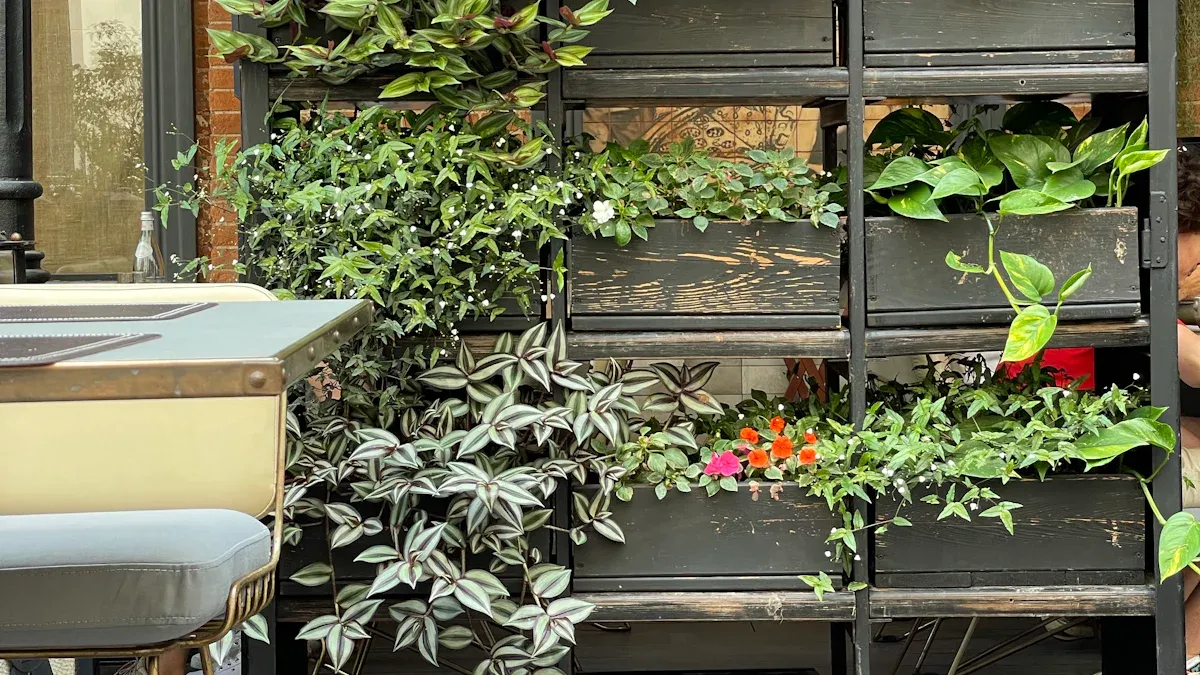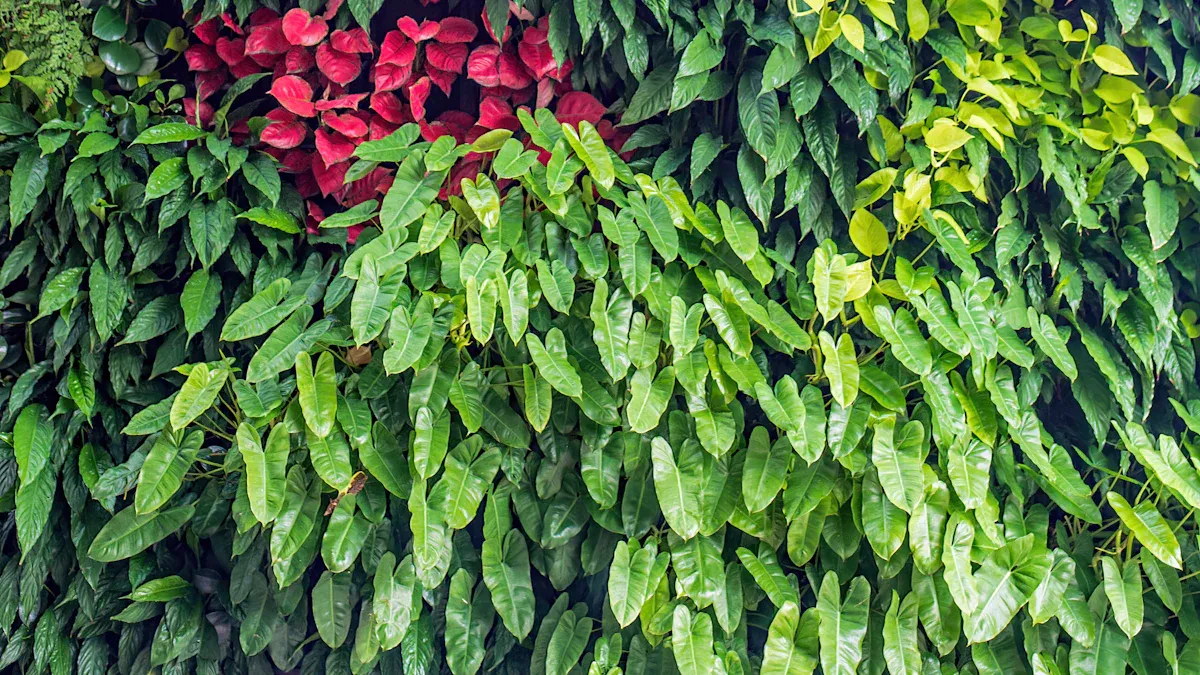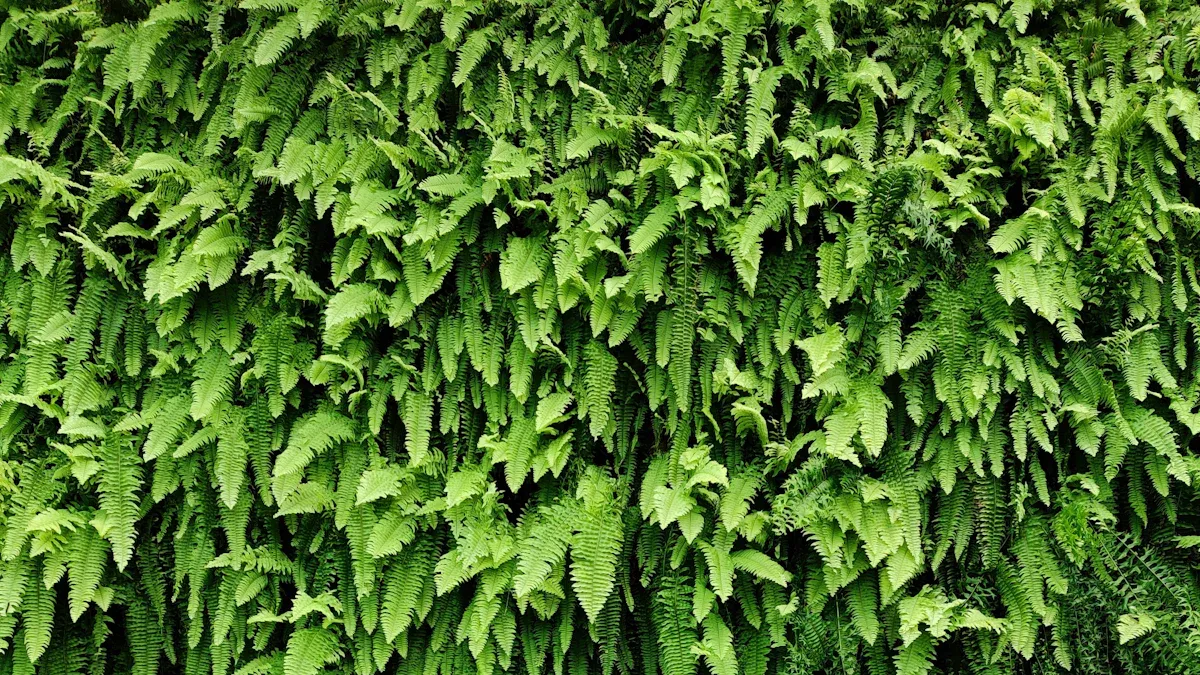
Wondering which plant varieties work best in vertical gardens? This guide highlights top picks that thrive in vertical settings, whether you want fresh herbs or colorful flowers.
Vertical gardening is a new way to grow plants in small areas, specifically through the use of plants vertical gardens. Learning how to grow a vertical garden, you will utilize walls or tall structures to cultivate greens, flowers, or leaves. You don’t need much soil, and plants grow upward, not outward. In crowded cities, plants vertical gardens are becoming very popular. They add greenery without using ground space, making them great for city life. Other benefits of vertical gardening include reduced pest exposure, improved air quality, and visual appeal. By 2030, vertical farming could be worth $25.34 billion. The benefits are clear—more plants, less space, and beautiful designs. What is a living wall? It’s a plants vertical garden that looks like art and turns walls into lively ecosystems.
Best Edible Plants for Vertical Gardens

Growing food in small spaces is possible with vertical gardening. But what are the best plants to grow this way? Let’s look at some great edible plants, from leafy greens to shade-friendly options.
Leafy Greens and Herbs
Leafy greens and herbs are easy to grow in vertical gardens. They fit well in small spaces and grow fast. You can use systems like pocket planters or hydroponics to grow them.
Leafy Greens: Spinach, kale, and lettuce are great choices. They don’t need much sunlight and grow quickly. These greens work indoors or outdoors.
Herbs: Basil, parsley, cilantro, and mint are perfect for small spaces. They’re easy to care for and can be picked often. Fresh herbs make cooking more fun!
Tip: Use pocket planters for herbs and greens. They save space and are easy to harvest. Vertical gardening helps you grow more in limited garden spaces, especially where ground area is scarce.
Climbing Vegetables and Fruits
Climbing plants grow upward, saving space in your garden. With supports, you can grow tasty vegetables and fruits that also look nice.
Vegetables: Cherry tomatoes, cucumbers, and pole beans are great climbers. They grow well in vertical setups and give lots of produce.
Fruits: Strawberries are a favorite for vertical gardens. They grow in hanging pots or tiered systems and look pretty too.
Did you know vertical farming produces more food per square foot than regular farming? One acre of vertical farming can equal 10 to 20 acres of traditional farming. That’s a big space saver!
Shade-Tolerant Edibles
Not all gardens get full sun, but you can still grow food. Some plants do well in partial or full shade, making them great for shaded vertical gardens.
Partial Shade: Lettuce, radishes, and chives grow fine with less sunlight. They’re easy to grow and add variety to your garden.
Full Shade: Watercress, lemon balm, and mint grow well in low light. These plants are tough and adapt easily.
Here’s a simple guide for picking plants based on sunlight:
Sunlight Condition | |
|---|---|
Plenty of Sunlight | Aloe Vera, Sage, Cherry Tomatoes, Spinach |
Partial Shade | Lettuce, Radish, Chives, Parsley, Basil |
Full Shade | Watercress, Lemon Balm, Violets, Mint |
Note: Match plants to your garden’s sunlight for better growth and harvests.
By picking the right edible plants, you can make a useful and pretty vertical garden. Whether it’s leafy greens, climbing veggies, or shade-loving plants, you’ll enjoy fresh food at home!
Best Ornamental Plants for Vertical Gardens

Ornamental plants are great for making vertical gardens beautiful. They add color, texture, and style to plain walls. Let’s look at some top plants that can improve your garden design.
Flowering Plants for Color and Beauty
Flowering plants make vertical gardens bright and cheerful. They add charm to both indoor and outdoor spaces.
Petunias and Geraniums: These flowers are simple to grow and come in many colors. Using bright blooms in vertical layers is a creative landscape design idea that enhances outdoor aesthetics. They do well in hanging pots or wall planters.
Begonias: These flowers bloom brightly and grow well in shaded spots. They give your garden a soft, pretty look.
Marigolds: These happy flowers look nice and keep pests away. They are a smart choice for gardens.
Flowering plants in vertical gardens are becoming more popular. People love giving flowers as gifts, and cities are adding greenery for beauty. Social media, like TikTok, has also inspired people to create floral displays.
Tip: Use flowers with different bloom times to keep your garden colorful all year.
Foliage Plants for Texture and Contrast
Foliage plants bring texture and variety to vertical gardens. They make your garden more interesting by mixing leaf shapes and sizes.
Ferns: These plants have soft, feathery leaves that add gentle texture.
Hostas: Their big, bold leaves make a strong statement in your garden.
Calatheas: These plants have patterned leaves that look fancy and elegant.
Mixing textures in a vertical garden creates a layered look. Big leaves like hostas add drama, while small leaves like ferns add detail. Together, they make a stunning display.
Note: Place foliage plants carefully to show off their unique patterns and textures.
Vines and Climbers for Vertical Impact
Vines and climbers are perfect for vertical gardens. They grow upward naturally and cover walls or trellises. They also make spaces feel lush and green.
English Ivy: This easy-to-grow vine grows fast and needs little care. It’s a favorite for vertical gardens.
Jasmine: This plant has pretty flowers and a sweet smell, adding beauty and fragrance.
Morning Glory: These vines grow quickly and have lovely, trumpet-shaped flowers.
Vines and climbers not only look good but also help cool walls and insulate them. They are both useful and attractive.
Pro Tip: Use trellises or wires to guide vines for a tidy look.
Choosing the right ornamental plants can make your vertical garden amazing. Whether you like flowers, textured leaves, or climbing vines, there’s a plant for every space and style.
How to Make the Best Plant Choices for Vertical Gardens
Picking the right plants for vertical gardens might seem tricky, but it’s simple if you focus on your space, sunlight, and how much care the plants need. Follow these steps to build a garden that works for you.
Checking Space and Plant Growth
First, look at how much space you have. Vertical gardens come in many sizes, so choose plants that fit well. Some plants grow tall and need more room, while others stay small and fit tight spaces. Avoid using deeply rooted plants in shallow vertical containers, as they require more soil depth and can become root-bound quickly.
Small Spaces: For small walls or balconies, pick compact plants like herbs, succulents, or tiny flowers. These plants are easy to handle and don’t need much room.
Larger Spaces: If you have big walls or tall structures, climbing plants like tomatoes, cucumbers, or ivy are great. They grow upward and allow for maximum use of space in tight areas.
Think about how plants grow. Some spread out, while others grow straight up. When planning your setup, avoid placing deeply rooted plants in small containers as their roots need more vertical depth to thrive. For example, pole beans and jasmine climb high, while lettuce and spinach grow in small bunches. These are perfect for pocket planters.
Tip: Use trellises or supports to guide climbing plants. This keeps your garden neat and organized.
Choosing Plants Based on Sunlight
Sunlight is very important for plant growth. Watch how much light your garden gets each day. Is it sunny, partly shaded, or mostly dark? Match plants to the light they need for the best results.
Full Sunlight: If your garden gets lots of sun, grow cherry tomatoes, basil, or marigolds. These plants love bright light and grow fast.
Partial Sunlight: For areas with some shade, try parsley, chives, or begonias. They don’t need as much sun but still grow well.
Low Light: If your garden is mostly shaded, don’t worry. Plants like mint, ferns, and watercress can grow in low light and still do well.
Studies show plants in bright light grow faster and have bigger leaves. For example, plants in full sun often grow taller and wider than those in shade. Knowing your garden’s light helps you pick the best plants.
Note: Turn your plants sometimes so they get light evenly. This helps them grow straight and healthy.
Thinking About Care and Watering
Some plants are easier to care for than others. If you’re busy or new to gardening, pick plants that don’t need much work. But all plants need water and care to grow well.
Many vertical gardens use drip irrigation systems. These systems send water straight to the roots, saving water and helping plants grow. Regular care, like checking for pests and adding fertilizer, keeps your garden healthy.
Here are some tips to make caring for your garden easier:
Pick drought-tolerant plants like succulents if you want to water less.
Use self-watering pots or irrigation systems to save time.
Group plants with similar water needs to avoid over- or under-watering.
Watering systems in vertical gardens help plants grow evenly and stay healthy. They also save water by reducing waste and runoff, which is good for the environment.
Pro Tip: Check your plants often for pests or diseases. Catching problems early can save your garden.
By thinking about your space, sunlight, and how much care plants need, you can choose the best ones for your vertical garden. Whether you grow herbs, flowers, or climbing veggies, these tips will help you create a beautiful and easy-to-manage garden. Try mixing a good variety of plants—from climbers and herbs to flowering foliage—for function and style.
Practical Tips for Vertical Gardening Success
Picking the Best Vertical Garden Structure
Choosing the right setup helps your vertical garden grow well. Different plants need different supports, so match the structure to your plants and space. Here are some good choices:
Trellises: Great for light climbers like pole beans or sweet peas. They work well in small gardens or modular systems.
Arches and Pergolas: Strong enough for heavy plants like grapevines. They also make your garden look fancy.
Wire Supports: Useful for training fruit trees to grow against walls. These hold up bigger plants easily.
If you enjoy DIY projects, try making your own trellises or arches. It’s a fun way to save money and personalize your garden.
Tip: Modular systems are simple to set up and fit small spaces. They’re perfect for beginners. Pocket planters are also a reliable starting point for those just getting into vertical gardening.
A modular vertical garden system allows flexibility to expand or rearrange sections as your plant collection grows.
Soil and Fertilizer Advice
Good soil is important for healthy plants. For vertical gardens, use lightweight soil that holds water but doesn’t get soggy. Adding compost or coco coir makes the soil better.
Picking the right fertilizer helps plants grow strong. Here’s a quick guide:
Fertilizer Formula | Amount per 1000 sq. ft. |
|---|---|
5-10-10 | 3.5 lbs |
6-18-6 | 2.9 lbs |
8-12-4 | 2.2 lbs |
10-10-10 | 1.8 lbs |
12-6-6 | 1.5 lbs |
16-16-16 | 1.1 lbs |

Note: Use slow-release fertilizers for pots to give steady nutrients.
Watering and Irrigation Tips
Watering vertical gardens can be tricky, but smart methods help. Know your local weather, like temperature and humidity, to decide how much water plants need.
Here are some easy watering ideas:
Drip systems: Send water straight to roots without wasting it.
Hydroponic systems: Save water and give nutrients directly.
Soil moisture monitors: Prevent overwatering or underwatering.
Zone watering: Adjust water for each plant’s needs.
Gravity systems: Spread water evenly in vertical setups.
Pro Tip: Group plants with similar water needs to make watering easier.
By choosing the right setup, soil, and watering plan, your vertical garden will thrive. Whether you grow veggies, flowers, or herbs, these tips will help your garden succeed.Some essential planting tips for vertical gardens include choosing shallow-rooted varieties, securing structures, and using lightweight soil.
Managing Pests and Diseases in Vertical Gardens
Keeping pests and diseases away is key for healthy vertical gardens. Plants grow close together, so problems can spread fast. But don’t worry! Simple steps can protect your plants and keep them strong.
Common Pests to Look Out For
Some pests enjoy vertical gardens too. Watch for these common ones:
Aphids: Tiny bugs that suck plant sap, making leaves curl.
Spider Mites: They spin webs and harm leaves by eating them.
Whiteflies: Small white bugs that weaken plants by stealing nutrients.
Tip: Check plants often for pests. Catching them early makes fixing easier.
Natural Pest Control Methods
You don’t need chemicals to fight pests. Try these natural ways:
Add Helpful Insects: Ladybugs and lacewings eat pests like aphids.
Spray Neem Oil: This natural oil keeps many pests away.
Grow Companion Plants: Basil and marigolds help repel bad bugs.
Stopping Plant Diseases
Diseases like mildew or root rot can hurt your garden. Prevent them by:
Allowing Airflow: Space plants so air can move around them.
Watering Carefully: Too much water can cause fungus problems.
Cleaning Tools: Dirty tools can spread diseases between plants.
Pro Tip: Change the plants you grow each season to avoid repeat diseases.
By staying alert and using natural fixes, you can stop pests and diseases. Healthy gardens mean happy plants and better crops!
Vertical gardening helps you grow plants in small spaces. It’s not only practical but also makes your area look nice. Famous projects like Bosco Verticale in Milan and Gardens by the Bay in Singapore show how these gardens improve cities. They add green spaces and help nature thrive. You can begin with a small setup, try out various plants, and see your garden flourish. Even a small courtyard can support a vertical garden with the right design and sunlight access. Whether you grow vegetables or flowers, vertical gardening adds fresh food, bright colors, and natural beauty to your home. It’s also an inspiring landscape design idea for maximizing visual interest in compact spaces.
FAQ
What are vertical gardens, and why are they popular?
Vertical gardens grow plants upward on walls or structures. They don’t need much ground space, making them great for cities. You can use them to grow food or decorate small areas.
Can I grow vegetables in vertical gardens?
Yes, you can grow vegetables like lettuce, cucumbers, and cherry tomatoes. These plants grow upward, saving space. Just make sure they get enough sunlight and water to stay healthy.
How do I water plants in vertical gardens?
Drip irrigation is the best way to water vertical gardens. It sends water straight to the roots and avoids waste. You can also use self-watering pots or check soil moisture often.
Are vertical gardens hard to maintain?
No, they’re easy to care for if you pick simple plants. Succulents and herbs are low-maintenance options. Check for pests, water when needed, and use light soil for better growth.
What plants grow well in shaded vertical gardens?
Plants like mint, ferns, and watercress grow well in shade. These plants handle low light and still grow strong. Choose plants based on how much light your garden gets.


